“A Home Song”
by
Henry Van Dyke
I read within a poet’s book
A word that starred the page:
“Stone walls do not a prison make,
Nor iron bars a cage!”
Yes, that is true; and something more
You’ll find, where’er you roam,
That marble floors and gilded walls
Can never make a home.
But every house where Love abides,
And Friendship is a guest,
Is surely home, and home-sweet-home:
For there the heart can rest.
Henry van Dyke’s sentimental poem, a reflection of the time before ubiquitous irony, still manages to strike at the truth of what we want our homes to be. If home is where our hearts can rest, how much more horrifying is it when the safety and comfort of home is destroyed?
For me, horror is best when it hits close to home: that is, when it strikes at those things we take for granted. Why, then, was this such a depressing month for horror viewing? Is it because the home invasion genre is incredibly repetitive? I felt like I was caught in a bad Philip Glass score; even the slight variations couldn’t break up the monotony. There were, at least, a few high notes in the din.
To start, you can’t talk about the home invasion genre without first mentioning Wes Craven’s The Last House On The Left. Borrowing its premise from Ingmar Bergman’s glorious though upsetting The Virgin Spring, which explores the same story from a different perspective, Last House is fascinating because it upends expectations by turning the tables on the would-be assassins who come to call.
Since then, however, home invasion horror along with remakes of the most popular and influential 70’s and 80’s horror films, have taken a decidedly unpleasant turn. After David Fincher’s brilliantly dour Se7en cast a haze of green rain over every horror cinematographer’s original thoughts, fright films took on a serious tone that saps them of their fun factor. A film-maker’s awareness of the need to entertain and engage saves horror films from pretentiousness while still allowing catharsis … or at least a chilling denouement. In the home invasion genre, most of the films I watched seemed to strive for Apocalypse Now levels of horror and may have achieved it – except for their vacuous content. Mostly they descend into sadism and leave you feeling hollow and dirty for having watched.
I have only a few to recommend this month. The first two are a fascinating comparison – nowhere near in the same league but good examples of how one story can be told from such shockingly different perspectives.
The Last House on the Left (1972) & The Virgin Spring (1960): Bergman’s The Virgin Spring is a dark fable about the destructiveness of revenge on the human soul. Craven’s Last House on the Left, notable for its graphic violence, including a brutal, extended rape sequence implies that cruel revenge is the best way to assuage your grief. (I Spit on Your Grave from 1978 bears a similar stamp of depravity.) Both are based on the same source material: a medieval, Swedish ballad about a couple who lose their daughter to murderous thieves on the road. When the thieves must seek shelter during that night’s storm, they unluckily find themselves at the home of the worried and eventually grief-stricken parents. Mayhem ensues.
In both films, the final act is taken up with the parent’s exacting of punishment on the criminals. Last House speaks to our baser instincts and gives the audience, the perverse pleasure of watching the murderers get their comeuppance. Unfortunately, Craven’s film has not aged well. The acting is stiff at best and sluggish shots of bucolic settings might warrant the use of your fast-forward button. A pair of bumbling cops are supposed to provide comedy but instead weaken the story’s structure. Don’t get me wrong – Craven makes some daring moves and the unbridled wickedness of the Manson-like criminals is strong. But, for instance, a scene where a woman bites off a man’s penis is as laughable as it is horrible.
There are no severed penises in The Virgin Spring. And it’s not a horror film, though the drama is told through Bergman’s dark visage. The story is the same, though set in medieval Sweden. Innocence is lost, a family destroyed, and revenge taken but only after much grief, sorrow and inner-turmoil. Bergman, in his usual way, is able to get to the heart while Craven goes for the gut. Max von Sydow as the grief-stricken father is extraordinary, as he was in all of Bergman’s films.
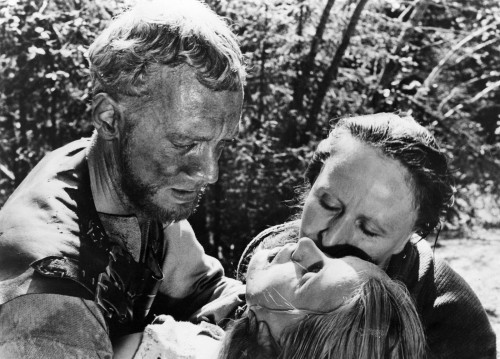
Grieved parents Max von Sydow & Birgitta Valberg discover the body of their daughter, played by Birgitta Pettersson.
I recommend both highly: The Virgin Spring for its artistry, Last House its importance in the horror genre – it was banned in several countries, in particular the UK, which has a history of banning films. This last bit I find really strange, since Britain’s Eden Lake (2008) which somehow eluded the censor’s gavel, is more cruel and violent than anything Craven has ever made.
SHOULD I WATCH BOTH OF THEM? If you’re serious about film, this is your homework.
Eden Lake (2008) – Can a film be excellently produced, directed, photographed, acted and still be unwatchable? Despite excellence in all the major technical areas, I hated this film.
Hated.
Assailants in these films can be mysterious ciphers who are never revealed (The Strangers), mysterious ciphers who are eventually revealed (Them) or a pair of clean-cut sociopaths (Funny Games). Of late, this genre’s only trick seems to be the most dire ending possible, leaving the audience in despair, in anger or, worse, sickened at having wasted 90-minutes being tormented by a filmmaker.
Michael Fassbender and Kelly Reilly, both excellent, play a couple whose outdoorsy weekend is obliterated by a sadistic group of working-class, teen thugs. Though not really a “home invasion,” I’m counting this couple’s weekend getaway as a home away from home. Pain, torture and disfigurement with buckets of blood to spare, an innocent child burned alive, and other horrendous goings-on make me question why anyone would watch this film, mainly because ***spoiler alert*** (sort of) there is no catharsis. Its unpleasant ending makes the rest of the film feel even nastier. ***end spoiler***
Though I suppose we are not meant to look deeper than the surface, what the film says about the working class – namely that that it is made up entirely of the cruel and stupid – is pure bigotry.
Calling this film “brutal” lends it a nobility it does not deserve. It is neither “brutal,” “daring,” “harrowing,” nor entertaining. Though it may be considered “provocative,” that word is also too highfalutin for Eden Lake’s unpleasantness. It’s a nasty, exploitative piece of work exemplifying the very thing Michael Haneke tries to address in Funny Games: namely, that we are willing to watch sadistic acts of violence under the guise of entertainment – and we are all of us no better for it.
SHOULD I WATCH IT? Why are you asking this?
Kidnapped (2010) – is not as exploitative as Eden Lake. But I still hated it. Like Eden Lake, it lacks a sense of playfulness. An audience that wants to be entertained is, instead, strapped to a chair and asked to endure 90 minutes of drilling without Novocain. I’m not implying that horror movies should be giving us Kristin Wiig cameos. Nor that they take the ironic tone which put Wes Craven back on the map with Scream. But there has to be some entertainment value.
Kidnapped is a tedious exercise in coitus-interruptus. A family’s first day in their new home becomes a lesson in dumb choices when they are attacked by a hooded band of sociopaths. Let me amend that: two sociopaths and one almost redeemable crook who thinks he is just there for the loot. After an hour of not-as-graphic-as-it-could-be-but-still-cruel violence, including a rape (of course), the family fights back in a brief, most unsatisfying way. Cue dumb, horror movie behavior.
The film is impressive for its technical aspects – it unfolds almost wholly in real time and was shot in 12 long, continuous takes (reference Hitchcock’s Rope). These complex shots are impressive but you watch the movie ever-aware of the film-maker’s presence. When the characters do something stupid, which is often (GIGANTICALLY stupid is the adverb that comes to mind), you wonder why the writer/director didn’t simply invent some other turn of plot.
Kidnapped (like Eden Lake) seems to have missed Haneke’s self-aware irony. It is a serious movie about a serious thing told very seriously which, in this case, means lots of blubbering, begging and gnashing of teeth, as well as some graphically broken limbs, a smashed (smashed!!) skull, psychological torture and one of our main characters cruelly shot point blank in the face. This is also the kind of a movie where a character walks away from the bad guy before making certain he is 100% dead. I’m sorry – but you have to do better than that.
It’s pretentious, overly serious and ultimately pointless. I need a shower.
SHOULD I WATCH IT? See above.
Funny Games (1997) – is Michael Haneke’s examination of violence in cinema. It begins, appropriately, with two games: one played by the director and the other by the family which is our focus. On the way to their vacation home, Mother, Father and Son and son are in the midst of a driving game: a peaceful selection by Handel, sung by tenor Benjamino Gigli, floats over the scene and Father must guess the name of the aria. Just as the family is looking most beatific, Haneke disrupts the shot with the film’s title – FUNNY GAMES – and the loudest, headbanging-est rock music imaginable. The kind of music that’s more noise than melody. We watch the family, still peaceful, oblivious to what we hear. The director is up to something. And the audience is in for something.
Eventually, the family is visited by two, clean-cut young sociopaths, beginning with a sequence in which one of them pretends at borrowing eggs for a neighbor. The quiet menace of this scene is played without interference by the director. It’s wonderfully shot – with our uneasiness growing as the gentility of the events becomes more and more peculiar.
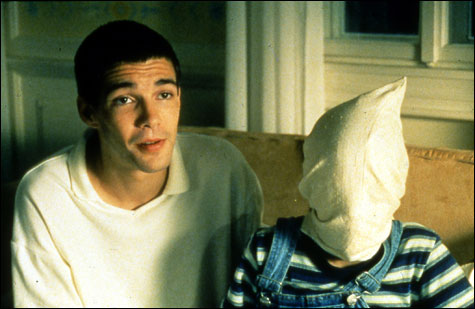
Cruelty abounds, mostly offscreen, in FUNNY GAMES, except, you know, for this scene where they put a bag over a kid's head.
The Brechtian devices Haneke employs keep us intellectually engaged (for a short time) but emotionally distant – as Brechtian devices are meant to do. Haneke is pointing the camera at us instead of at the story but his notes on the film make me wonder who he believes his intended audience to be. According to Haneke, the film examines
…the oscillation between the disconcerting feeling of taking part in a real happening, and the emotional security of seeing only the depiction of an artificially created or even discovered reality.
If the film’s audience is the art-house theatre-goer rather than the thrill-seeker, he is preaching to the choir. The conceit wears thin and I found myself wanting to be emotionally engaged instead of intellectually challenged – mainly because I was ahead of the game twenty-five minutes in. I got the point. Would teen-age boys, who are the target audience for Hostel and Saw, go and see a film like Funny Games? Watching it again for the purpose of this article nearly put me to sleep. The film is condescending to the point of exhaustion.
Still, I appreciate Haneke’s attempt even if his presumptuousness reminds me of one of those Europeanm pseudo-intellectuals telling Americans how awful and stupid we are. We know all that. Please say something enlightening or go outside to smoke.
SHOULD I WATCH IT? Only if you’re a cinephile.
When a Stranger Calls (1979) is best-remembered for its opening salvo, a 20-minute suspense grind briefly depicted in its memorable TV commercial.
The plot may have been overly familiar even in 1979: young babysitter is terrorized by creepy phone calls (Black Christmas, Sorry Wrong Number, and the list goes on) but When a Stranger Calls has a fascinating, minimalist screenplay – there are few characters, even fewer situations, and its abbreviated structure leaves little room even for character development (which is not necessarily a good thing but is, at least, consistent with its style.) Certainly a flawed film but with enough moments to recommend it.
Carol Kane, Colleen Dewhurst, Charles Durning and Tony Beckley (as the madman) all do a bang-up job of bringing the sparse screenplay to life. Kane is particularly good as babysitter Jill Johnson even though she disappears during the film’s peculiar middle section depicting the madman’s escape from a mental institution and his pursuit by private detective (Durning.) The madman terrorizes an aging barfly (Dewhurst) who is eventually enlisted to help trap him. Trying to bring these separate storylines together never quite works – even with the excellent performances of Dewhurst, Durning and Beckley (who was suffering from cancer during the filming of When A Stranger Calls, dying just after principal photography was complete.)
Ultimately, When a Stranger Calls is a bit of a mess but has moments of greatness which help it rise above its bland remake. The middle section feels dire and lonely with our three characters each on their own trajectory, their lives empty of any human connection. When Jill (Kane) reappears in the final third, it’s a relief to see her again; we are back in the world of home, comfort, and care. You’re glad Jill is leading a happy life with children of her own and a devoted husband. You root for her partly because Kane is so winning in the role. It’s a reminder that a scream queen needn’t be one of those homogenized starlets who pepper horror remakes these days. Kane was unique and while she is known as a kooky comedian these days (her work in The Princess Bride is priceless), this movie proves that her career could easily have taken a different path.
This is a movie from the days before cell phones. Jill must keep the madman on the phone in order that the call can be traced. She asks, “What do you want from me?” The response – simple, direct, horrifying – is one of the screenplay’s dark, minimalist gems: “Your blood all over me.”
SHOULD I WATCH IT? Only when you know exactly where your children are.
The Strangers (2007 but released in 2008) and Them (2006) were made just one year apart and on different continents but are unfortunately similar. With the American horror market so reluctant to embrace foreign films, The Strangers developed legions of American fans who have never seen the superior French film which is its twin.
Them is made with the care and expertise one would lavish on a more “serious” subject. As with the best of this genre, we are given characters to care about who put into a desperate situation, turning the next 90 minutes into one long suspense sequence. In Them, Lucas (Michaël Cohen) and Clémentine (Olivia Bonamy) are spending the weekend at their country home. Their love and affection is so honest that, 30 minutes into the film, you wish it was a romance instead of the horror it will become. Soon enough, their home is under siege by unseen forces. When we find out who “Them” are (is?), the reveal chills us to the bone. In The Strangers, however, we meet our couple, Kristen (Liv Tyler) and James (Scott Speedman) at a moment of crisis in their relationship – spending a weekend at a vacation house after a friend’s wedding. Lucas and Clémentine are so happily paired, we are struck even harder by their danger but with James and Kristen we want them to work out their differences.
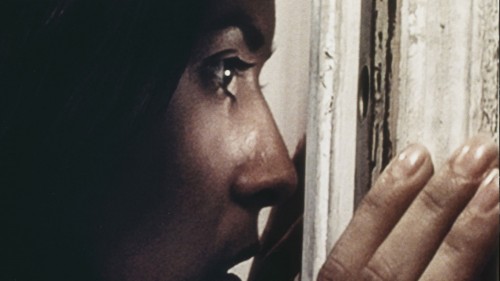
Really awful things can happen when you look through keyholes in horror movies. (Olivia Bonamy in THEM.)
The Strangers is “inspired by true events,” a disingenuous attempt to make the movie seem like a true story. Hogwash. The Strangers isn’t based on anything, it is inspired by something that happened to writer/director Bryan Bertino when he was a teenager. Bertino says a stranger knocked at his door, asked for someone who wasn’t there, and left. Woah. Scary.
So, in other words, some people came to Bertino’s door when he was a kid, nothing happened, and he used his imagination to write what could possibly have happened – as if everything a writer pens is not inspired by some real event. (Bertino also says that the film is based on the Manson murders. So which is it?) Them is also, supposedly, based on a real incident in which an Austrian couple vacationing in Romania were attacked by a group of sociopaths – specifically like those in the film. If the internet is to be believed, at least the situation in Them closely resembles the film.
Both films benefit from very good acting, character development and a“slow build” but I prefer Them because The Strangers eventually devolves into cliché and repetitiveness. The chill of The Strangers is in the killers’ response to “why are you doing this?” but it is ultimately unsatisfying whereas Them leaves you with an unshakable, shivery feeling.
SHOULD I WATCH THEM? One is exceptional. The other is decent.
High Tension (2003) is so close – SO CLOSE – to being a perfect horror film. But there’s that g*damn stupid ending!!!! Let me explain:
This is a French horror flick written and directed by Alexandre Aja (who shares writing credits with Grégory Levasseur.) In terms of disappointment, it’s the home-invasion equivalent of Insidious: a strong opening act is laid waste by the silly final third. High Tension loses its whatsie under the weight of a twist that is not so much a surprise as a cheat.
Borrowing heavily from Dean Koontz’s novel, Intensity (filmed for TV in 1997 with the excellent Molly Parker of Deadwood), even its title is too-close-for-comfort. Though there is no credit given to Mr. Koontz, the first act of the film seems structured from the same outline.
Two college friends, Marie and Alexia (Cécile De France and Maïwenn, respectively) take a weekend away at Alexia’s family farmhouse but their idyll is destroyed when a murderous, cigar-smoking Frenchman shows up to dispatch anyone he finds. Alex’s entire family is on the hit list: mother, father, pre-teen brother and dog. Alex is miraculously spared and Marie, her friend, is clever enough to elude the killer. The middle of the film takes us on the road as the killer bundles Alex into his very strange, armored van and Marie, evading detection, climbs in beside her.
There are 2 exceedingly grisly murders early in the film which, in their graphic way, are gorgeously photographed and staged. (I bet you’ve never seen anyone murdered with a chest of drawers before.) A third murder happens at a distance and is hauntingly cruel. The film’s idyllic opening, torn apart by this violence, sets us up for the suspense that follows. What else, you wonder, might this film have up its sleeve?
The film gives us two likeable and lovely heroines whose friendship and personalities are quickly and efficiently developed. They are in stark contrast to the murderer who is an amalgam of gross masculinity. Wearing a stained mechanic’s coverall, he is gruff, silent, square-faced, with bulbous features and fat, dirty fingers – looking every bit like a nightmare image of a middle-aged, child molester. He is excellently played by Philippe Nahon. (It should be noted that the entire cast – even a gas station attendant in a few brief scenes – play their roles with unswerving conviction.) Once Alex and Marie are put into mortal peril at his hands, the viewer can’t help but go along for the ride. The suspense is wonderfully unbearable, though a random sex-with-a-severed-head moment should have been left on the cutting room floor. When the murderer stops at a roadside gas-mart, tormenting the attendant before buying a bottle of liquor, Marie gets the attendant on her side. We think there might be a chance – even during a dread-inducing sequence in the men’s rest room – that Alex and Marie could escape with their shattered lives.
Then – horror fans be warned – the movie is spoiled by that twist – as if M. Night Shyamalan fell asleep on his keyboard. It is the equivalent of “it was all a dream.” (Don’t worry, that’s not a spoiler.) Not only does the reveal render the first two acts entirely implausible but the movie loses credibility on repeated viewings. Had the filmmakers trusted the integrity of their story, High Tension would be one of the most brutally satisfying horror films of the decade – living up to its title. Instead, we are cheated by the director who has spent the first two acts lying to us.
SHOULD I SEE IT? Yes. But you have been warned about that twist.
Black Christmas (1974) is my favorite film this month. I’ll say as little about the plot as possible to avoid spoiling its mystery. Maybe I shouldn’t build it up so much but it’s such a satisfying little thriller that giving away any of its minimal plot points would ruin the delicate framework. It was directed by Bob Clark whose A Christmas Story is so utterly goofy it’s hard to believe Black Christmas is the vision of the same man. Though there are touches of comedy (some of it forced) in the latter, the scary bits set a very high bar for low budget horror.
A houseful of sorority sisters, alone for the Christmas holiday, are terrorized by a madman who is taken at first for a prank caller. His ghastly phone calls become increasingly sadistic as the girls are picked off one by one. Familiar stuff? Yes. It’s not a masterpiece but any fan of quality film-making will recognize its virtues in a genre where so few films have any originality. This entry into the main-stream slasher genre has been endlessly imitated.
Starting out at a leisurely pace, it picks up energy and grows more shocking as it goes. Balanced with excellent performances from the exquisitely beautiful Olivia Hussey, young Andrea Martin, Margot Kidder and John Saxon, this one has characters to care about and a killer who remains a mystery like the monster under your childhood bed. Sophie’s Choice it ain’t, so the character development isn’t deep, but each of the actors gives in.
The original Black Christmas (not the poo-poo stinky awful terrible bad remake) is the kind of film where the audience cried out audibly when our heroine is clutched at by the killer through the stair-railing, her hair entangled in his creepy fingers. So little gore and so much payoff! Black Christmas rewards you with several serious creep-out moments and a freaky, Freaky, FREAKY scary-boo sound design (pay close attention to those phone calls). Those godforsakenly tense phone calls and a few brief shots of a hand, an eye, an arm, are all we see of the intruder and Clark’s restraint in this regard is absolute genius.
Horror movie fans fall into two categories: people who think gore equals horror and people for whom mood, tension and originality are important. Fast food junkies and those with short attention spans won’t get Black Christmas but stick with it until the end and it will leave you afraid to be alone on a dark night.
SHOULD I WATCH IT? Yes. With your Christmas lights lit, egg nog in hand, and a close friend who never leaves your side.

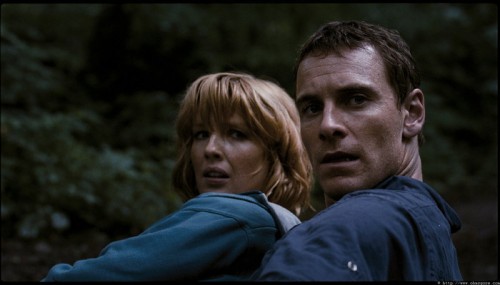

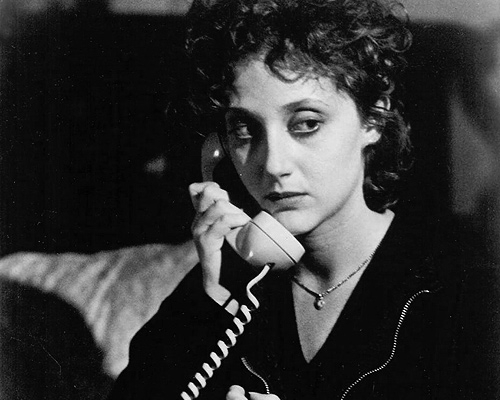
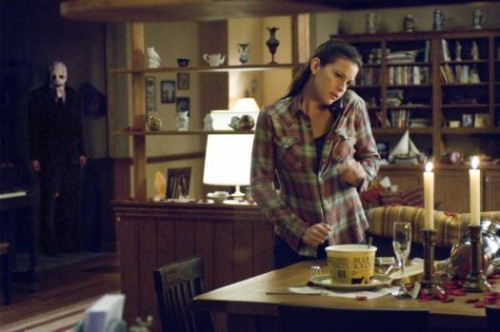
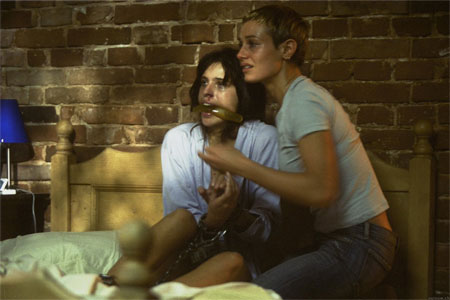
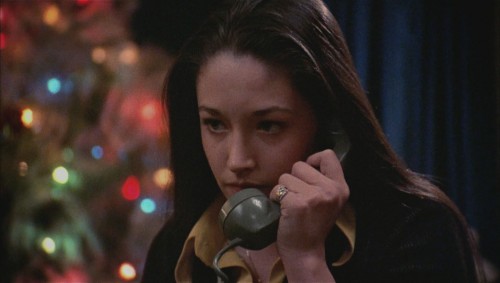
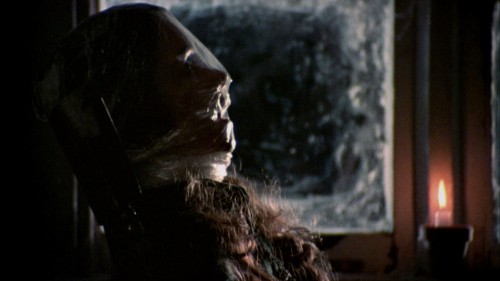


Interesting survey. I was haunted by FUNNY GAMES, especially the intense performance of the wife/mother, and I enjoyed (if that’s the word) Naomi Watts’ performance in the same role in the American remake (also by Hanneke). Not knowing any of the actors in the original, it felt more real for the extended set-up, whereas seeing Boyd Gaines in a small role in the remake took me out of the film for a moment or two.
About halfway through FUNNY GAMES I found myself ahead of the game, if you will. I knew where it was going but I will say that I was engaged the first time I saw it. There are some excellent sequences and the performances are quite excellent in both versions. I’m particularly fond of the German cast but, ultimately, I find the movie’s deliberate self-consciousness a bit confusing.
You are right about THEM. I watched it last night and really enjoyed it. I also realized at a couple points that I was physically lost in the house/surroundings, and I didn’t really care, I was so caught up in the action. I was aghast at the reveal, but I had other ideas that (to me) were even more horrifying. Also, loved the sound design in this one. Creepy choices.
From what I remember, I think I liked the end of HIGH TENSION more than you did. Ah, to each their own.
One more thing…a great take on the “home” theme was ATTACK THE BLOCK. Fun, unique and enjoyable. Not perfect by any means, but I always appreciate a fresh approach. It’s a bunch of London teenagers protecting their neighborhood from an Alien invasion.
ATTACK THE BLOCK has been selected for an upcoming post. It’s already in the works…
Great items from you, man. I have be aware your stuff prior to and you are just extremely magnificent.
I really like what you have received right here,
certainly like what you are saying and the way in which in which
you say it. You’re making it entertaining and you still care for to keep
it sensible. I cant wait to read much more from you. That is actually a great website.
My website :: Barbie